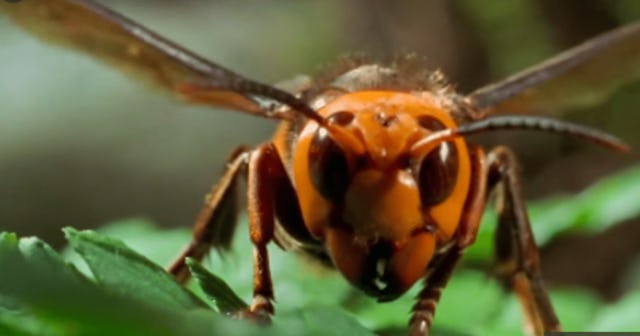'Murder Hornets' Found Their Way To The U.S., So That's Cool

A murder hornet’s stinger can puncture a beekeeping suit
To the tune of, “Can 2020 possibly get any worse?” Yes. Yes, it can. Apparently, a nearly two-inch long insect known as the “murder hornet” has made its way to the U.S. for the first time ever, so that’s cool.
The Asian giant hornet, Vespa mandarinia, has been found in the U.S. recently, and, according to The New York Times, has been known to kill around 50 people a year in Japan, with similar numbers in China. What’s more, it has the potential to eradicate the U.S. honey bee population, which is already in decline in recent years. Honey bees are critical to our nation’s food industry, pollinating plants producing fruit, nuts, and vegetables.
Per the Times, these murder hornets “use mandibles shaped like spiked shark fins to wipe out a honeybee hive in a matter of hours, decapitating the bees and flying away with the thoraxes to feed their young.” If that sentence alone doesn’t haunt your dreams forever, here’s one that might — the murder hornet’s stinger is tough enough to pierce a beekeepers’ suit.
As news of the hornet’s arrival made its way into the news in recent days, people took to Twitter to react because — if you don’t laugh and all that:
One researcher in Canada, where the hornets have also infiltrated, said the hornets penetrated both his beekeeping suit and layers of sweatpants underneath. “It was like having red-hot thumbtacks being driven into my flesh,” Conrad Bérubé, a beekeeper and entomologist, said. The next day, Bérubé said he felt like he had the flu.
If you feel you need more details while you lay awake at night pondering your existence (and a video of the murder hornet attacking its prey), here’s a short piece from National Geographic that should help.
The hornets have been in the U.S. since December when the Washington State Department of Agriculture verified four reported sightings. “Hornets are most destructive in the late summer and early fall, when they are on the hunt for sources of protein to raise next year’s queens,” Truscott said on the WSU’s Insider. “They attack honey bee hives, killing adult bees and devouring bee larvae and pupae, while aggressively defending the occupied colony. Their stings are big and painful, with a potent neurotoxin. Multiple stings can kill humans, even if they are not allergic.”
With the most obvious advice ever, entomologist Chris Looney of the state Department of Agriculture says, “Don’t try to take them out yourself if you see them. If you get into them, run away, then call us!”
We think we speak on behalf of everyone when we say, Yikes.
This article was originally published on